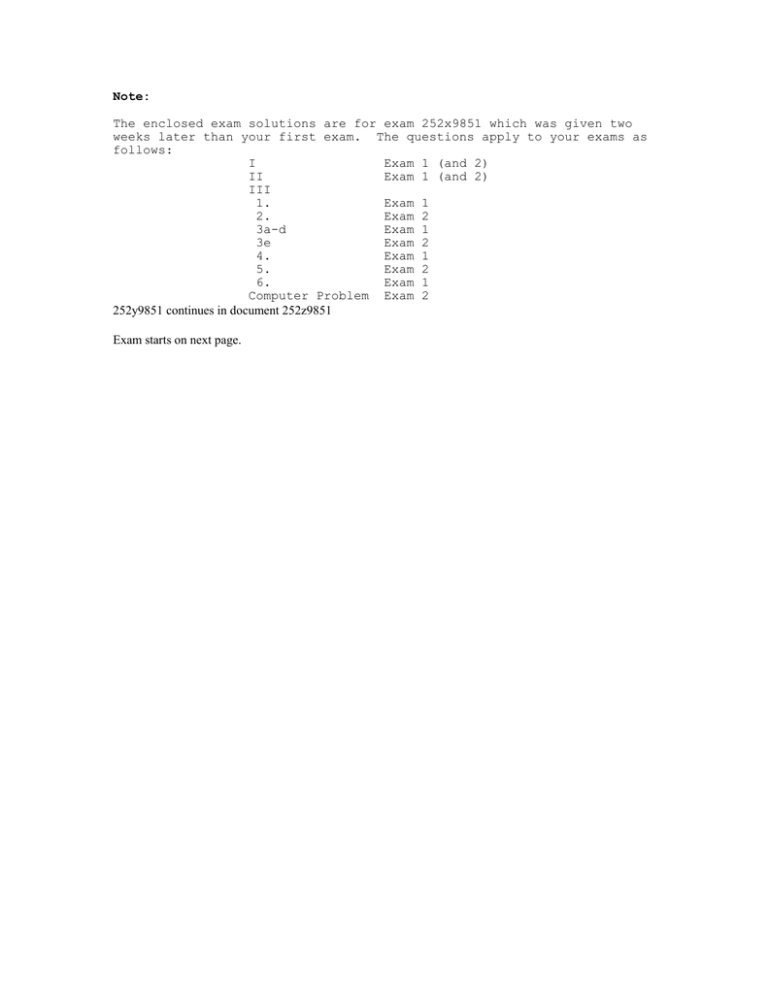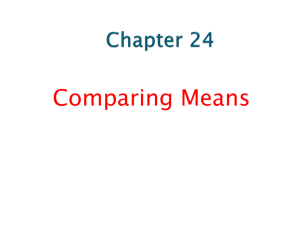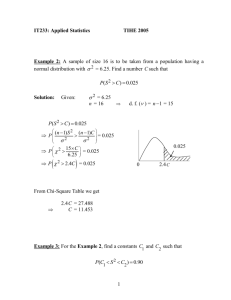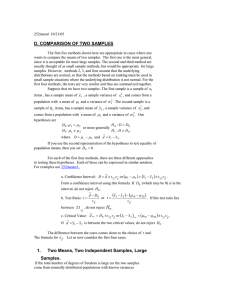Note: The enclosed exam solutions are for exam 252x9851 which was... weeks later than your first exam. The questions apply...
advertisement

Note: The enclosed exam solutions are for exam 252x9851 which was given two weeks later than your first exam. The questions apply to your exams as follows: I Exam 1 (and 2) II Exam 1 (and 2) III 1. Exam 1 2. Exam 2 3a-d Exam 1 3e Exam 2 4. Exam 1 5. Exam 2 6. Exam 1 Computer Problem Exam 2 252y9851 continues in document 252z9851 Exam starts on next page. 10/23/98 252y9851 ECO252 QBA2 FIRST HOUR EXAM October 17, 1998 Name Show your work! I. (14 points) Do all the following. x ~ N 1.5,8 1. 30 1.5 1 1.5 z P1 x 30 P P 0.06 z 3.56 8 8 P 0.06 z 0 P0 z 3.56 .0239 .4998 .5237 5 1.5 5 1.5 z 2. P 5 x 5 P P 0.81 z 0.44 8 8 P0.81 z 0 P0 z 0.44 .2910 .1700 .4610 9 1.5 3 1.5 z 3. P3 x 9 P P0.19 z 0.94 8 8 P0 z 0.94 P0 z 0.19 .3264 .0753 .2511 0 1.5 4. Px 0 P z P z 0.19 8 P0.19 z 0 Pz 0 .0753 .5000 .5753 1.5 1.5 7 1.5 z 5. P 7.0 x 1.5 P P 1.06 z 0 .3554 8 8 6. A symmetrical interval about the mean with 63% probability. We want two points x .1850 and x.8150 , so that Px.1850 x x .8150 .6300 . From the diagram, if we replace x by z, P0 z z.1850 .3150 . The closest we can come is P0 z 0.90 .3159 . So z.1850 0.90 , and x z.1850 1.5 0.908 1.5 7.2 , or –5.7 to 8.7. 7. x.045 We want a point x .045 , so that Px x .045 .045 . From the diagram, if we replace x by z, P0 z z.045 .455 . The closest we can come is P0 z 1.70 .4554 . So z.045 1.70 , and x z.045 1.5 1.708 1.5 13 .6 , or 15.1 . 2 10/23/98 252y9851 II. (6 points-2 point penalty for not trying part a.) Show your work! Samples of five automobiles from one manufacturer and six automobiles from a second manufacturer were tested for top speeds. These are listed below. Assume that we were sampling from a normal distribution. Manufacturer 1 Manufacturer 2 Automobile Speed Automobile Speed 1 110 1 115 2 135 2 130 3 125 3 140 4 185 4 190 5 130 5 135 6 142 Note that x 2 142 , s 2 25.4165 a. Compute the sample variance, s1 , of the top speed of automobiles for the first manufacturer. Show your work.(3) Solution: x1 x 685 137 n x 5 97075 5137 2 n 1 4 807 .5 or s1 28.4165 . s12 2 nx1 2 Manufacturer 1 2 3 4 5 Total x (Speed) 110 135 125 185 130 685 x2 12100 18225 15625 34225 16900 97075 . b. Compute a 99% confidence interval for the mean top speed, 1 , of automobiles for the first manufacturer.(3) Solution: From the problem statement .01 . From page 10 of the syllabus supplement, if the population variance is unknown x t s x and t n21 t .4005 4.604 . 2 s x1 s1 n 807 .5 28 .4165 12 .7083 . So 1 137 4.604 12.7083 137 58.51 or 76.49 to 195.51. 5 5 3 10/23/98 252y9851 III. Do at least 3 of the following 6 Problems (at least 10 each) (or do sections adding to at least 30 points Anything extra you do helps, and grades wrap around) . Show your work! 1. Using the data from the previous problem (page 2.), test the hypothesis that the population mean, 1 , for the first manufacturer is 135 at the 99% confidence level using: a. A test ratio (2) b. Critical values (2) c. A confidence interval (2) d. Find an approximate p-value for the null hypothesis. (1) e. Now find a 95% confidence interval for the standard deviation.(3) Solution: From page 10 of the Syllabus Supplement: Interval for Confidence Hypotheses Test Ratio Critical Value Interval Mean ( known) x z x Mean ( unknown) x t sx 2 2 DF n 1 H 0 : 135 H 1 : 135 H0 : 0 z H1 : 0 H 0 : 0 H1: 0 t x 0 x x 0 x cv 0 z 2 x x cv 0 t 2 s x sx 4 10 135 , DF n 1 4, .01, tn 1 t .005 4.604 2 From the previous page: x1 137 and s x1 s1 807 .5 28 .4165 12 .7083 . 5 5 n x 10 137 135 0.1574 . This is in the 'accept region' a. Test Ratio: t s x1 12 .7083 between -4.604 and +4.604, so accept H 0 . b. Critical Value: xcv 10 t sx1 135 4.604 12.7083 135 58.51 or 76.5 2 to 193.5. This includes x1 137 , so accept H 0 . c. Confidence Interval: 1 x1 t s x1 137 4.604 12.7083 137 58.51 2 or 78.5 to 195.5. This includes 10 135 , so accept H 0 . 4 0.134 , so that, if this were a 1-sided test, we could say d. From the t table t = 0.1574 is smaller than t .45 pvalue 45 . Since this is a 2-sided test, we double p-value, and say pvalue 90 . e. From page 1 of the Syllabus Supplement: n 1 s 2 2 2 Since 2 .025 and 1 2 4807 .5 2 4807 .5 1 11 .1433 0.2158 17.025 1 122 .342 . 2 n 1 s 2 2 1 4 2 4 and .975 . So .975 , look up .2025 . DF n 1 4 and .05 . 2 n 1s12 .2025 12 n 1s12 .2975 or or 289.86 12 14967.56 . Finally, taking square roots, 4 10/23/98 252y9851 2. Repeating the data from the previous problem: Manufacturer 1 Automobile Speed 1 110 2 135 3 125 4 185 5 130 Manufacturer 2 Automobile Speed 1 115 2 130 3 140 4 190 5 135 6 142 Note that x 2 142 , s 2 25.4165 Test the hypothesis that cars produced by the second manufacturer have higher top speeds than those produced by the first manufacturer by comparing means using: a. A test ratio (3) b. Critical values (2) c. A confidence interval (2) d. Find an approximate p-value for the null hypothesis. (1) e. Now find a 95% confidence interval for the ratio, 1 , of standard deviations.(3) 2 Note: You may assume either (i) that population variances are the same for the two parent populations or (ii) that they are not equal, but if you assume that they are not equal part a) is 5 points and b) and c) are 3 points each. So, indicate what you assume. f. Do a test to see if the which of the two assumptions is correct. (2) Solution: From page 10 of the Syllabus Supplement: Difference H 0 : 0 * d t 2 sd between Two H 1: 0 1 1 Means ( sd s p 1 2 n1 n2 Unknown, DF n n 2 1 2 Variances Assumed equal) 2 s12 s22 n1 n2 sd DF s12 s22 n 1 n2 sˆ 2p H 0 : 0 * d t sd Difference Between Two Means( Unknown, Variances Assumed Unequal) t t H 1: 0 1 2 d cv 0 t 2 sd d 0 sd n1 1s12 n2 1s22 n1 n2 2 d cv 0 t 2 sd d 0 sd 2 s12 2 n1 n1 1 s 22 2 n2 n2 1 Recall that. x1 137 , s1 28.4165 , n1 5 and x 2 142 , s 2 25.4165 , n 2 6 H0 : 0 d x1 x2 137 142 5 (i)Assume sˆ p 12 22 n1 1s12 n2 1s22 n1 n2 2 1 1 n1 n2 428.41652 525.41652 9 717 .7758 1 1 263 .1845 16 .2230 1 2 0 (ii)Assume 12 22 717 ,7758 26 .7913 sd s p H1 : 0 5 6 s12 28 .4165 2 161 .4995 n1 5 s22 25 .4165 2 107 .6156 n2 6 2 2 If we sum these s1 s2 =269.1151. n1 n2 10/23/98 252y9851 5 Equal variances Unequal variances sd 16.2230 DF n1 n2 2 5 6 2 9 s12 s22 n1 n2 sd 269 .1151 16 .4047 DF s12 s22 n 1 n2 s12 2 n1 n1 1 2 s 22 2 n2 n2 1 269 .1151 2 161 .4995 2 107 .6156 2 4 8.1959 5 Use 8 degrees of freedom. t a) d 0 50 0.3082 sd 16 .2230 9 t t.025 2.262 So accept H 0 2 b) d cv 0 t 2 sd 0 2.262 16 .2230 36.70 Accept H 0 c) d t sd 2 5 36.70 t a) d 0 50 0.3047 sd 16 .4074 8 t t.025 2.306 so accept H 0 2 b) d cv 0 t sd 2 0 2.306 16 .4074 37.84 Accept H 0 c) d t sd 2 5 37.84 The interval includes 0, so accept H 0 . The interval includes 0, so accept H 0 . 9 9 d) t.35 0.398 t.40 0.261and our t 0.3082 . So for a 1-sided test we would get .35 p value .40 , but this is a 2-sided test, so .70 p value .80 . 8 8 d) t.35 0.399 t.40 0.262 and our t 0.3047 . So for a 1-sided test we would get .35 p value .40 , but this is a 2-sided test, so .70 p value .80 . 6 10/23/98 252y9851 e) From page 11 of the Syllabus Supplement: Interval for Confidence Hypotheses Interval Ratio of 22 s22 DF1 , DF2 H 0 : 12 22 F Variances 12 s12 .5 .5 2 H 1 : 12 22 1 DF1 , DF2 F1 2 DF1 , DF2 DF1 n1 1 F 2 Test Ratio Critical Value F DF1 , DF2 s12 s22 and DF2 n2 1 F DF2 , DF1 2 .5 .5 2 or 1 2 s22 2 s1 2 12 s12 ( n2 1, n1 1) 1 22 s22 DF1 , DF2 means s1 F as is explained in “Confidence Limits and F 12 s12 .5 .5 2 s 22 Fn1 1, n2 1 22 s 22 2 2 Hypothesis Tests for Variances”. So 5, 4 F.025 9.36 and 1.25 e) s12 s 22 28 .4165 25 .4165 2 2 s12 s 22 2 1 s2 ( n 1, n1 1) 1 1 2 n1 1, n2 1 2 s 2 F 2 F 2 2 4, 5 7.39 , . Now F.025 2 1.250 , so s12 s 22 12 s12 (5, 4) 4,5 2 s 2 F.025 becomes F.025 2 2 1 2 2 1 12 1.259.36 . So 0.169 12 11 .7 . 7.39 2 2 H 0 : 12 22 H 1 : 12 s2 F 5, 4, 22 s1 2 2 is tested by using F 4,5 25 .4165 2 28 .4165 2 s12 s 22 28.4165 2 25.4165 2 4, 5 7.39 and 1.25 against F.025 5, 4 9.36 . The second test is unnecessary due to the fact that 0.800 against F.025 all F s on the table are above 1. Since in both tests, the F ratios are below the table values, accept H 0 . 7 10/23/98 252y9851 3. Data from section II is repeated below. Manufacturer 1 Manufacturer 2 Automobile Speed Automobile Speed 1 110 1 115 2 135 2 130 3 125 3 140 4 185 4 190 5 130 5 135 6 142 Note that x 2 142 , s 2 28.4165 a. Test that the population mean, 2 (second sample), is 135 assuming that the parent population is normally distributed and that the sample of six is taken from a population of 40. (3) b. Drop the assumption that the parent distribution is normal ( and that the population size is 50) and figure out a confidence level for the confidence interval ( 130 142 ) (3) c. Put a p-value on the statement that the median is 129, again assuming that the distribution is not normal. (2) d. Looking at your result in c, would you reject the hypothesis that the median is 129 at the 90% confidence level? Explain. (1) e. Test the hypothesis that cars produced by the second manufacturer have higher top speeds than those produced by the first manufacturer by comparing medians assuming that the parent populations are not normal. (5) Solution: a) H 0 : 2 135 H1 : 2 135 5 5 2.571 . 10 135 , DF n 1 5, .01 or .05, tn 1 t .005 4.032 or t .025 2 x 2 142 and s x 2 (i) Test Ratio: t s2 n2 N 2 n 2 25 .4165 N 2 1 6 40 6 9.6883 . 40 1 x 20 142 135 0.7225 . This is in the 'accept region' sx2 9.6883 between t5 and , t5 so accept H 0 . 2 2 or (ii) Critical Value: xcv 10 t sx1 135 t5 9.6883 . This includes x 2 142 , so accept H 0 . 2 2 or(iii) Confidence Interval: 2 x 2 t s x1 137 t 52 9.6883 . This includes 10 135 , so accept H 0 . 2 b) If we put our data in order, we get: ( x1 is the original numbers in order, r1 is their rank.) If we look only at x 2 , the confidence interval ( 130 142 ) is wrong if 5 or x1 r1 x 2 r2 110 125 1 3 115 130 2 4.5 130 4.5 135 135 6.5 140 185 10 142 190 25 6.5 8 9 11 41 more numbers are above the median or 5 or more numbers are below the median. From the binomial table for n 6 and p .5 we find that Px 5 Px 1 .10938 . The probability we want is the probability of one of two different events with probability .10938, so our significance level is .21878 and the confidence level is 1 - .21878 =.78124. 8 10/23/98 252y9851 c) To test the statement H 0 : 129 , note that in x 2 there are five numbers above 129. If 129 is the median the chance that any one number is above the median is .5. Since we expect that 3 out of 6 will be above the median, and because this is a 2-sided test, the p-value is 2Px 5 21 Px 4 21 .89062 .21876 . d) Since our significance level is 10% and the p-value is above that, accept H 0 : 129 . e) H 0 : 1 2 H 1 : 1 2 Using Table 5 for the Wilcoxon Rank Sum test for independent samples, if W = 25 ( This is the smaller rank sum on the bottom of page 7 in this document), its p-value is .214. If the significance level is 5% or 10% we accept H 0 . If we use Table 6b for a 5% one-tailed test, we find that the accept region is between 20 and 40, so accept H 0 . Exam solution continues in 252z9851.doc 9



